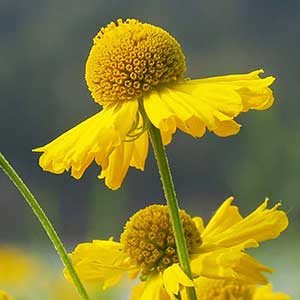Helenium autumnale
Helenium bigelovii
common sneezeweed, fall sneezeweed, hélénie automnale, large-flower sneezeweed, mountain sneezeweed
Bigelow's sneezeweed, tall sneezeweed, tall sneezweed
1(–7), branched distally, strongly winged, sparsely to densely hairy proximally, moderately to densely hairy distally.
1–3(–10), unbranched or sparingly branched distally, weakly to moderately winged, glabrous proximally, glabrous or sparsely hairy distally.
usually moderately to densely hairy, sometimes glabrous;
basal blades (withered by flowering) lanceolate, oblanceolate, or obovate, entire or weakly lobed;
proximal and mid blades obovate to oblanceolate, usually dentate or entire;
distal blades oblanceolate to lanceolate, entire or dentate.
glabrous or sparsely hairy;
basal blades oblanceolate to oblong-elliptic, entire;
proximal and mid blades lanceolate to oblong-elliptic, entire;
distal blades linear to lanceolate, entire.
3–10 cm, moderately to densely hairy.
(6–)10–30 cm, sparsely to moderately hairy.
globoid, 8–20 × 8–23 mm.
hemispheric to globoid, 12–20 × (14–)17–22(–25) mm.
8–21, pistillate, fertile;
corollas yellow, 10–23 × 4–10 mm.
14–20, pistillate, fertile;
corollas yellow, 13–25 × 5–10(–12) mm.
200–400(–800+);
corollas yellow proximally, yellow to yellow-brown distally, 2.4–4 mm, lobes 5.
250–500(–800+);
corollas yellow proximally, yellow to brown to purple distally, 3–4.4(–4.8) mm, lobes 5.
(connate proximally) moderately to densely hairy.
(connate proximally) moderately to densely hairy.
5–70(–100+) per plant, in paniculiform arrays.
1–20 per plant, borne singly or in paniculiform arrays.
1–2 mm, sparsely to moderately hairy;
pappi of 5–7 entire, aristate scales (0.5–)0.9–1.5(–1.8) mm.
1.8–2.4 mm, moderately hairy;
pappi of 6–8 entire, aristate scales 1.3–2.2(–2.7) mm.
= 32, 34, 36.
= 32.
Helenium autumnale
Helenium bigelovii
- Local floras:
BC,
CA,
OR,
WA
- Local Web sites:
CalFlora,
CalPhotos,
Flora NW,
Go Botany,
IL Wildflowers,
KS Wildflowers,
LA Plants,
MD Biodiversity,
MI Flora,
MO Plants,
PNW Herbaria,
Turner Photog.
WildflowerSearch
iNaturalist (observations)
USDA Plants Database
- LBJ Wildflower Center
- SEINet
- Plants of the World Online
- Encyclopedia of Life
- Wikipedia
- Google Image Search


